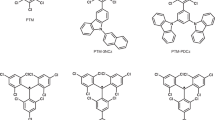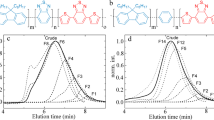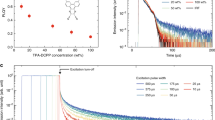Abstract
PREVIOUS work1 has shown that in polymers when initiators decompose into primary free radicals chemiluminescence is produced in the visible region of the spectrum. When dicyclohexylperoxy-dicarbonate (P.C.) decomposes in polycarbonate, polystyrene arid polymethyl methacrylate two maxima in the chemiluminescence spectra are observed at λ = 4500 Å and λ = 5300 Å, each apparently arising from a different elementary reaction. The short-wave-length chemiluminescence probably results from cage disproportionation of radicals from the initiator  giving an electronically excited cyclohexanone molecule in its triplet state. The nature of the elementary reaction giving rise to the long-wave chemiluminescence is as yet unknown.
giving an electronically excited cyclohexanone molecule in its triplet state. The nature of the elementary reaction giving rise to the long-wave chemiluminescence is as yet unknown.
This is a preview of subscription content, access via your institution
Access options
Subscribe to this journal
Receive 51 print issues and online access
$199.00 per year
only $3.90 per issue
Buy this article
- Purchase on Springer Link
- Instant access to full article PDF
Prices may be subject to local taxes which are calculated during checkout
Similar content being viewed by others
References
Phillips, D., Anissimov, V., Karpukhin, O., and Shliapintokh, V., J. Amer. Chem. Soc., (in the press).
Perrin, F., C. R. Acad. Sci., 178, 1978 (1924).
Ermolaev, V. L., Usp. Fiz. Nauk, 80, 3 (1963).
Föster, Th., Disc. Faraday Soc., 27, 7 (1959).
Author information
Authors and Affiliations
Rights and permissions
About this article
Cite this article
PHILLIPS, D., ANISSIMOV, V., KARPUKHIN, O. et al. Energy Transfer from Chemiluminescent Species in Polymers. Nature 215, 1163–1165 (1967). https://doi.org/10.1038/2151163a0
Received:
Issue Date:
DOI: https://doi.org/10.1038/2151163a0
Comments
By submitting a comment you agree to abide by our Terms and Community Guidelines. If you find something abusive or that does not comply with our terms or guidelines please flag it as inappropriate.



